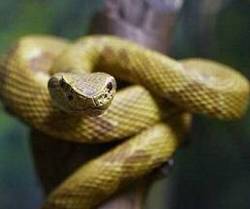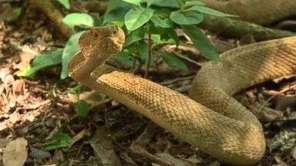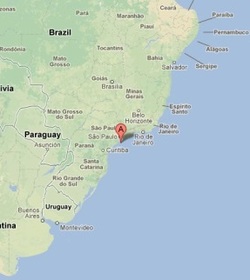Golden lanceheadBothrops insularis |

Custom Search
|

It's also uninhabited and travel to the island is forbidden by the Brazilian navy, and there is a good reason, it is home to several thousand venomous golden lancehead snakes.
The island is a subtropical or tropical moist forest containing several different types of habitats including forest, clearings, and shrubs. The climate is very mild, and the temperatures never fall below 64ºF (18ºC), or over 72ºF (22ºC). They can usually be found seeking shelter among leaf litter or in rock crevices, especially during unfavorable weather or after having just ingested a prey. But are also found in the trees hunting for prey. The golden lancehead grows to an average length of 28 inches (70 cm) but it's known to reach 46 inches (118 cm) in maximum length. The snake's color pattern consists of a series of triangular or quadrangular blotches, that may be broader or narrow, and alternating or opposite along the back overlaid in a pale yellowish brown ground color. The golden lancehead belly is a uniform pale cream or yellow, and they lack a well-defined postorbital stripe. When in captivity, their yellowish color often becomes darker.

Their common name "lancehead" refers to the distinctive head shape of all Bothrops genus snakes, which is elongated and comes to a point at the nose.
The golden lancehead has a longer tail than the jararaca (Bothrops jararaca), its closest relative, which probably an adaptation to help them maneuver through the trees found in the island. Venom / Bite These are highly venomous snakes but since the golden lancehead only inhabits an area uninhabited by humans, there has never been a recorded bite by one. But other lancehead species are responsible for more human deaths than any other snakes in both North and South America. The chemical analysis of their venom suggests that it's 5 times more potent than that of their cousin the jararaca (Bothrops jararaca), and is also the fastest acting venom in their genus. The mortality rate for other lancehead species envenomations is around 7%, if the victim doesn't receive medical treatment, but even if the patient receives treatment the bite is fatal on 3% of the cases. The effects of lancehead venom include local pain and swelling, nausea and vomiting, blood blisters, bruising, blood in the vomit and urine, intestinal bleeding, kidney failure, brain hemorrhage and severe necrosis of muscular tissue. Lancehead snakes have an hemotoxic venom that eats away at flesh and tissue to help digest the prey before they swallow it, but the golden lancehead also has some neurotoxic components in their venom to help killing the prey. Diet / Feeding Their diet consists mostly of perching birds, but they have been reported to eat lizards or even resort to cannibalism. The golden lancehead newborn and juvenile snakes prey mainly upon invertebrates. Because there are no mammals native to the island Queimada Grande, this has undoubtedly had a profound impact on their evolution. Reproduction
The golden lancehead mating season occurs during August and September, and these vipers are known to mate using both the ground or trees. Like most other viper species, the golden lancehead gives birth to live young. The average litter size around 7 newborns, and there is no recorded data about their size at birth, but one would expect it be similar to that of the Jararaca (about 10 inches). Conservation / Threats In the IUCN Red List the golden lance head is classified as critically endangered, this is due to several factors, but the main threat to the species is the habitat destruction. In the past, fires were deliberately started on the island in an attempt to eradicate the snakes so it could be used for agriculture. To maintain the lighthouse on the island, the Brazilian Navy has also contributed to habitat destruction by the removal of vegetation. The species was also plagued by over harvesting from scientists. The island of Queimada Grande is the only place in which these snakes are found in the wild, but it can only support a limited snake population due to its small size of only 43 hectares. This also leads to a large amount of inbreeding within the golden lancehead population and the occurrence of "intersexes" (specimens born with both male and female reproductive parts) this is harmful because most of the intersexes are born sterile. |
Did You Know?
The australian inland taipan bite contains venom enough to kill up to 100 full grown men. Scientific classification |
© 2014 Snake Facts About Us | Privacy Policy | Contact






